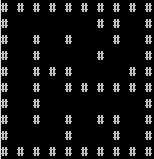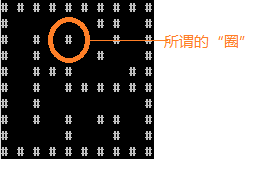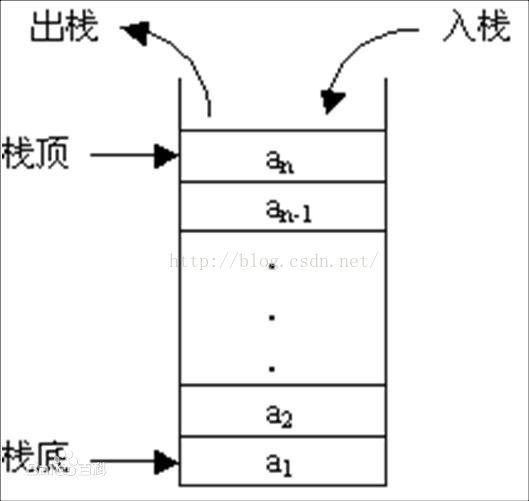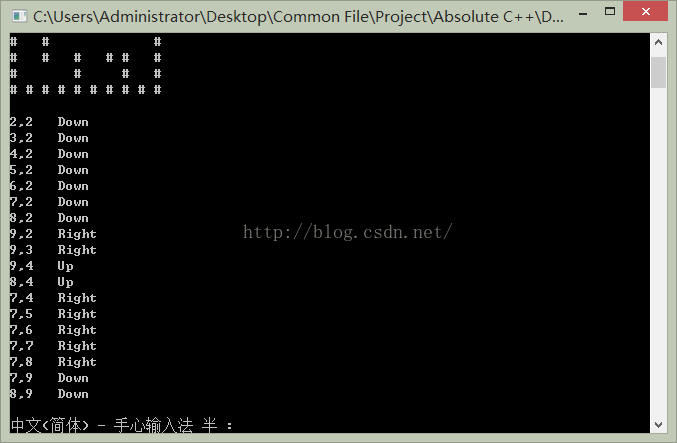迷宫算法及数据结构分析(by WIzaRD_ssc)
关于迷宫,承载着我们童年中的点滴记忆。当然,那时候总有些迷宫册子,每本还有专门的主题(奥特曼,葫芦娃,铠甲勇士什么的= =)。而且不得不说,真是干一行爱一行,这些出册子的人,把迷宫这个游戏可是上升到了一个高度。就比如说什么“碰见怪兽了要折返”什么的。
以上基于我们的童年,更基于那些“伟大的”迷宫设计设计师们。但是,在计算机行业领域中,我们更看重数据,以及对数据的运算和处理。所以 解决迷宫问题 就成了初学者对计算机编程技术及思想的一次质的飞跃。
好,废话不多说,接下来,我将从对迷宫算法的分析,数据结构的选择,及程序的实现进行简略描述。
1)迷宫算法的分析:
在计算机中,为了着重数据操作,我忽略掉了类似立交桥般复杂的线路,以及小怪兽的设定等。
如图左上角空白(#为边界,空白即指无字符的地方)为起点,右下角为终点。此迷宫中最需要我们想到的该是有岔道,还有圈。
也就是说程序应当有排除岔道,还有排除圈的能力。对于排除岔道,只要判断当前位置对于行迷宫者来说是否为#即可,而对于圈,我们可以用一个mark数组来标记此位置是否走过,每当向下一个位置走时就同时判断是否为#和此位置是否走过即可(这两个判断在下文直接简称为“通路成立判断”)。
以上仅解决了两个小问题,而更重要的是:行迷宫者到底如何走,是让它一直向上走,还是一直向右走,还是转着圈走。当我们在想它如何走时,方法就出现了。我们可以记录当前坐标值,然后对周围四个方向,即上,下,左,右依次进行“通路成立判断”,如果成立,按成立的那个方向移动一格,并再次让程序进行周围四个方向,即上,下,左,右依次进行“通路成立判断”。当四个方向的“通路成立判断”都不成立,那么就知道此路不通,接着让行迷宫者按原路返回,并继续进行没有判断完的方向(例如,某个位置向左可以走,但移动后发现四个方向的“通路成立判断”都不成立,那么此时倒退回去,并接着进行右的“通路成立判断”(因为判断顺序为上,下,左,右))就这样,让程序不断地做此种循环,直到当前坐标值等于终点坐标值。
但是,我们的目的是为了让程序求显示出求解过程,以上只是让行迷宫者走到了终点,而并没有记录他的行迹。接下来,我对存储路径的数据结构的选择进行描述。
2)数据结构的选择
栈是后进先出的线性数据结构,当每走一格时,就对上一格的坐标和向下一格要走的方向进行记录(即遵从:当前坐标+方向=下一格要走的坐标=路径描述)。并规定每当遇到死路,即四个方向的“通路成立判断”都不成立时,从栈中取出栈顶元素(因为栈顶恰好是上一步的路径描述)。就这样到当前坐标值等于终点坐标值时,及循环停止时,栈中的所有元素自下而上就是对路径的全部描述。
紧接着,可以根据算法与数据结构编出程序来,下面就是程序的实现。
3)程序的实现
#include
#include
#define Max_Size 100
using namespace std;
enum Direcation
{
Up = 1,
Down = 2,
Left = 3,
Right = 4
};
typedef struct
{
int x, y;
}Coordinate;
typedef struct
{
Coordinate coord;
Direcation direcation;
}Node;
class Stack
{
public:
Stack();
bool IsEmpty() const;
bool IsTopful() const;
bool Push(Node Pushed);
bool Pop();
const Node& GetTop() const;
void Output() const;
private:
Node stack[Max_Size];
unsigned int top;
};
void Check(const bool MAZE[][10], bool MARK[][10], Stack &wizard, Coordinate coord);
void OutputMaze(const bool MAZE[][10]);
const Coordinate Origin = { 1, 1 }, Terminal = { 8, 8 };
int main()
{
Stack wizard;
Coordinate coord = Origin;
bool MAZE[10][10]={
{1, 1, 1, 1, 1, 1, 1, 1, 1, 1},
{1, 0, 0, 0, 0, 0, 1, 1, 0, 1},
{1, 0, 1, 0, 1, 0, 0, 1, 0, 1},
{1, 0, 1, 0, 0, 0, 1, 0, 0, 1},
{1, 0, 1, 1, 1, 0, 0, 0, 1, 1},
{1, 0, 1, 0, 1, 1, 1, 1, 1, 1},
{1, 0, 1, 0, 0, 0, 0, 0, 0, 1},
{1, 0, 1, 0, 1, 0, 1, 1, 0, 1},
{1, 0, 0, 0, 1, 0, 0, 1, 0, 1},
{1, 1, 1, 1, 1, 1, 1, 1, 1, 1}};
bool MARK[10][10] = {
{ 0, 0, 0, 0, 0, 0, 0, 0, 0, 0 },
{ 0, 1, 1, 1, 1, 1, 1, 1, 1, 0 },
{ 0, 1, 1, 1, 1, 1, 1, 1, 1, 0 },
{ 0, 1, 1, 1, 1, 1, 1, 1, 1, 0 },
{ 0, 1, 1, 1, 1, 1, 1, 1, 1, 0 },
{ 0, 1, 1, 1, 1, 1, 1, 1, 1, 0 },
{ 0, 1, 1, 1, 1, 1, 1, 1, 1, 0 },
{ 0, 1, 1, 1, 1, 1, 1, 1, 1, 0 },
{ 0, 1, 1, 1, 1, 1, 1, 1, 1, 0 },
{ 0, 0, 0, 0, 0, 0, 0, 0, 0, 0 }, };
Check(MAZE, MARK, wizard, coord);
OutputMaze(MAZE);
wizard.Output();
cout << "9,9 !\n\n";
system("pause");
return 0;
}
void Check(const bool MAZE[][10], bool MARK[][10], Stack &wizard, Coordinate coord)
{
Node now;
MARK[coord.x][coord.y] = false;//mark
if (MARK[coord.x - 1][coord.y] && MAZE[coord.x - 1][coord.y] == 0)//up
{
if (coord.x == Terminal.x&&coord.y == Terminal.y) return;//1.check true or false
now.coord = coord; now.direcation = Up;//2.unload
wizard.Push(now);//3.push to stack;
coord.x--;//4.change moveable coordinate
Check(MAZE, MARK, wizard, coord);//5.provide the coordinate at present
}
else if (MARK[coord.x][coord.y - 1] && MAZE[coord.x][coord.y - 1] == 0)//left
{
if (coord.x == Terminal.x&&coord.y == Terminal.y) return;
now.coord = coord; now.direcation = Left;
wizard.Push(now);
coord.y--;
Check(MAZE, MARK, wizard, coord);
}
else if (MARK[coord.x][coord.y + 1] && MAZE[coord.x][coord.y + 1] == 0)//right
{
if (coord.x == Terminal.x&&coord.y == Terminal.y) return;
now.coord = coord; now.direcation = Right;
wizard.Push(now);
coord.y++;
Check(MAZE, MARK, wizard, coord);
}
else if (MARK[coord.x + 1][coord.y] && MAZE[coord.x + 1][coord.y] == 0)//down
{
if (coord.x == Terminal.x&&coord.y == Terminal.y) return;
now.coord = coord; now.direcation = Down;
wizard.Push(now);
coord.x++;
Check(MAZE, MARK, wizard, coord);
}
else
{
if (coord.x == Terminal.x&&coord.y == Terminal.y) return;//1.check true or false
coord = wizard.GetTop().coord;//2.change moveable coordinate
wizard.Pop();//3.delete
Check(MAZE, MARK, wizard, coord);//4.provide the coordinate at present
}
return;
}
void OutputMaze(const bool MAZE[][10])
{
for (int inset = 0; inset < 10; inset++)
{
for (int inset1 = 0; inset1 < 10; inset1++)
{
if (MAZE[inset][inset1])
cout << "# ";
else
cout << " ";
}
cout << endl;
}
cout << endl;
}
Stack::Stack()
{
top = 0;
}
bool Stack::IsEmpty() const
{
return (top == 0);
}
bool Stack::IsTopful() const
{
return (top == Max_Size + 1);
}
bool Stack::Push(Node Pushed)
{
if (IsTopful())
return false;
else
{
stack[top] = Pushed;
top++;
return true;
}
}
bool Stack::Pop()
{
if (IsEmpty())
return false;
else
{
top--;
return true;
}
}
const Node& Stack::GetTop() const
{
return stack[top - 1];
}
void Stack::Output() const
{
for (unsigned int inset = 0; inset < top; inset++)
{
cout << stack[inset].coord.x + 1 << ',' << stack[inset].coord.y + 1 << " ";
switch (stack[inset].direcation)
{
case Up:cout << "Up"; break;
case Down:cout << "Down"; break;
case Left:cout << "Left"; break;
case Right:cout << "Right"; break;
default:cout << "Unknow";
}
cout << endl;
}
cout << endl;
return;
} 


